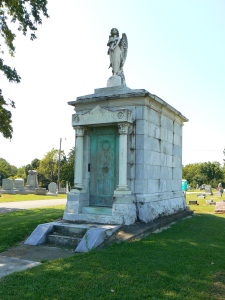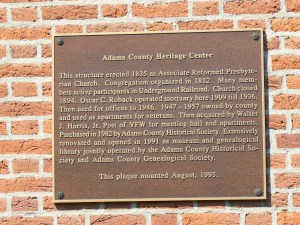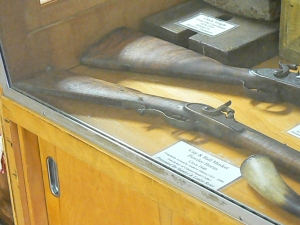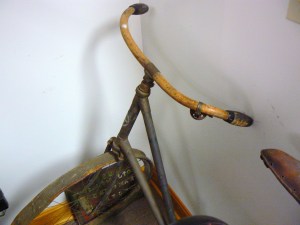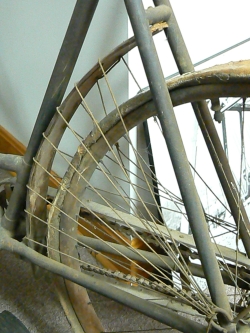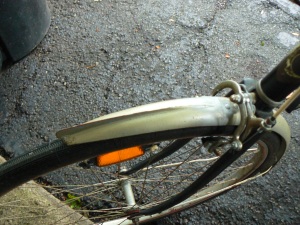Winter is a rough season for cyclists. We want to keep riding to stay in shape, but the weather rarely cooperates. I ride outdoors in winter, but it’s an iffy proposition. Riding a road bike in the snow is NOT recommended, so one must wait for the snowplow to do its job, then pray for sufficient sun to melt off the road surface before venturing out. “Sun”, by the way, is a term not recognized by native Clevelanders. I only know the meaning of the word because I was born far south of here. As a result of all this, the average cyclist can’t do much outdoor riding in the winter. Oh, and did I mention that winter starts right after Halloween and ends somewhere around Memorial Day? Yeah, and spring is a theoretical season that is said to occur during that twenty-four hour period between winter and summer, at which point the temperature and humidity both shoot up to the high 80’s and everyone heads for the beach, only to find that the lake is still frozen. But I digress….
A couple of years ago, I purchased a bicycle trainer in the hope of keeping in shape over the winter. This year I set it up in the living room and I’m trying to force myself to use it at least five days a week. For those of you who don’t have or haven’t seen one of these things, it’s definitely not like riding a bike outdoors. The trainer is a stand in which you clamp the rear axle of your road bike. The front wheel sits in a stationary cradle. The rear wheel drives a roller, which is attached to a resistance unit, which uses either a torque converter of sorts or a pair of magnetic discs to provide adjustable drag on the wheel. My trainer is a fluid model, which uses a torque converter thingy attached to a five-position shift lever mounted on the handlebars. You can use both the fluid shift and the gears on your bike to change the amount of work required to pedal the bike. So there’s a wide range of adjustment possible, but it’s still not easy. You can’t coast, you must move the pedals continuously. And, unless you set an electric fan in front of the bike, there’s no airflow, so you sweat at an incredible rate. Nashbar, Performance, and some other companies sell a sort of “bra” to catch the sweat and keep your bike’s frame from corroding, but I think the fan is probably the best solution, especially for the comfort factor. Most cyclists don’t realize how much cooling effect they get from the forward movement of the bike, but a half hour of pedaling in dead air will make you realize how much sweat you’re generating over the course of your ride.
I started on the trainer, as I do most years, shortly after the holidays. At this point in the year I’m usually about ten pounds heavier than my “normal” weight. This year it’s closer to twenty; I’ve been spending a lot more time at home, cooking a lot more than usual, and just plain enjoying myself way too much. I had to start out wearing my “fat” shorts, pair of Canari padded cycling shorts that won’t even stay up when I’m in shape. They fit great right now!
Sally’s decided she wants to get ready for riding season as well, so we’ll be swapping bikes on the trainer and taking turns from here on in. Misery loves company!
Product information and tips: I use a Travel Trac Century V Fluid+ Trainer with a CycleOps Climbing Block to cradle the front wheel. Both products are excellent and highly recommended. A fluid trainer is definitely superior to a magnetic one – smoother, quieter, and more easily adjusted. And the CycleOps block gives you three height options, plus you can stack multiple blocks to simulate steeper climbs if you wish. Be sure to put a mat down to cover and protect your floor covering – I use a six-foot length of vehicle carpeting, available in the automotive section of many big box stores for cheap. When setting up the trainer, you’ll probably need to readjust your saddle height and position. Make sure the saddle is fairly level, and adjust the front wheel height as needed to balance your weight distribution. Too much weight on the hands can be really uncomfortable when training indoors (especially when you’re out of shape in the first place). Don’t forget to wear your cycling socks, gloves, shorts and shoes – the same one’s you would wear on a fitness ride. Otherwise, you’ll get blisters for sure. I find that I get a really good, sweaty workout in about 30 minutes. Good luck with your training!




 Posted by danakennedy
Posted by danakennedy 